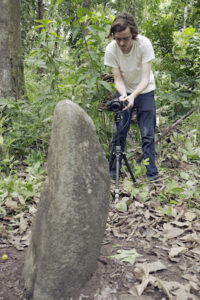
Photo of Ferdinand Saumarez Smith on site in eastern Nigeria.
Cultural Property News is pleased to publish “Thefts, Fakes and Facsimiles: Preserving the Bakor Monoliths of Nigeria,” together with an interview with author and researcher Ferdinand Saumarez Smith and additional photographs of this remarkable digital documentation project. The text originally appeared in the digital book, The Aura in the Age of Digital Materiality: Rethinking Preservation in the Shadow of an Uncertain Future, issued by Factum Foundation, Silvana Editoriale, 2020.
Ferdinand Saumarez Smith has worked with Factum Foundation since 2014 as a technical specialist, project developer, and curator, including on a number of rock art related projects in Scotland, Chad, Easter Island, and Brazil. Over the past six years he has been working in south-eastern Nigeria to preserve and promote the Bakor monoliths, which will culminate in an exhibition at The British Museum in Spring 2022 (Covid-19 situation depending). Previous exhibitions include “Soane’s Ark: Building with Symbols” which was held at Sir John Soane’s Museum in London in 2017, and which explored the great English architect’s relationship with freemasonry. In addition to his work with Factum, Saumarez Smith is currently writing his doctoral dissertation at King’s College London titled Eleusis and Enlightenment: The Problem of the Mysteries in Eighteenth-Century Thought.
A new Interview in Cultural Property News, Interview: Factum Foundation’s Ferdinand Saumarez Smith on Preserving the Bakor Monoliths, updates and expands on this article.
Over the past three years Factum Foundation has collaborated with the Trust for African Rock Art (TARA) and the University of Calabar (UNICAL) on a project aimed at documenting, preserving and raising awareness about the Bakor monoliths, also known as the ‘Cross-River’ or ‘Ikom’ monoliths, and locally referred to as ‘akwanshi’ or ‘atal’. The Bakor monoliths take their name from a group of linguistically and ethnically related communities (‘clans’) in an area of approximately 350 square miles in the Middle Cross River region in which they are exclusively found.
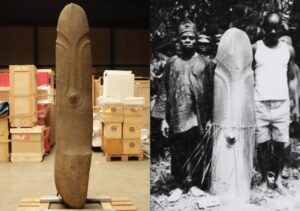
Oyengi monolith in the collection of Didier Claes and in Allison’s survey 1961/62.
The word ‘Bakor’ means ‘come and take’, a name that was chosen as a collective title because the phrase is identical in the languages of each of the original eight clans that make up the Bakor people. Referring to them as the ‘Bakor’ monoliths, rather than the ‘Cross-River’ (the state) or ‘Ikom’ (the nearest large town) monoliths as was formerly customary, respects the unique ownership of the monoliths by this people. Furthermore, the meaning of the word perhaps has some ironic value, since one of the main problems that has beset their preservation has been theft.
The material of the monoliths is primarily basalt or limestone that has been naturally shaped in nearby riverbeds and they generally range from about 40 cm up to 2 m in size, with a few exceptional cases reaching up to 3 m. The natural form of the rock is embellished by carvings of facial features, beards, protruding navels and decorative symbols, which distinguish each as a specific ancestral clan leader. These symbols and patterns serve as visual proof of the connection to the Bakor people: photographic evidence from the early 1960s demonstrates that the same motifs of concentric circles which are found on the monoliths were tattooed, using scarification techniques (Fig. 1), on the faces of local inhabitants.

Oyengi monolith in Allison’s survey 1961/62 and in the collection of Pierre Dartevelle.
The age of the monoliths remains the subject of speculation, particularly in the absence of proper archaeological investigation, although a 2020 dig supervised by UNICAL and Ahmadu Bello University, Zaria, will hopefully shed further light on the question. It seems probable that, since each monolith represents one clan leader, the tradition developed over a number of centuries, gradually falling out of practice over the period of British colonial influence. This must, however, have occurred at some time before direct colonial engagement in the area as the earliest account, Charles Partridge’s Cross River Natives (1905), demonstrates that the inhabitants had already lost the custom of producing them.
The situation of cultural disconnect today has been exacerbated by the strong influence of Pentecostal Christianity in Nigeria, which associates the monoliths with ‘juju’, or black magic. Nevertheless, some communities still retain practices and rituals associated with the monoliths, particularly at the time of the yam festival in September.

Monolith at Old Nkrigom.
The monolith sites can be roughly divided into three categories: those enclosed by a perimeter wall (Alok and Emangebe); those which have been subsumed by farmland (e.g. Manden, Nkunkundah); and those which remain in forested areas (Nkrigom, Egunonkwor). Although the first category has helped combat the problem of theft, concrete walls destroy the atmosphere that can be experienced in the original forest context. Furthermore, it has not stopped the practice of burning to remove vegetation, although this is less damaging as the grass is not allowed to grow as much as in the farmland. Slash and burn farming has caused enormous damage to many of the monolith sites, with the extreme heat followed by rapid cooling leading to cracks in the monoliths, which in turn has facilitated theft, particularly of the carved faces (Fig. 2). The monolith sites in the forest are generally the best preserved and have suffered the least from theft, although in sites such as Nkrigom falling trees have also caused damage.
In the course of four trips to the Bakor region (supported initially by the Prince Claus Fund and later by Jim and Paula Crown, the US Ambassador’s Fund for Cultural Preservation, and the Carène Foundation), the team visited almost all sites recorded during fieldwork conducted by Philip Allison in 1961–62. With the particular help of Chief Sylvanus ‘Orlando’ Akong, a number of others not yet documented were also identified.
These include Egunonkwor (Allison documented only part of a site by that name of which we were unable to recognise any monoliths), Ekeleboghor, Ekpara, Lowya, Manden (Allison’s ‘Manden’ site is actually Mkpananfa) and Nkunkundah. Compared to the near 300 monoliths identified by Allison, our project has recorded approximately 215 – thus up to one third of the total have been removed since the late 1960s.1
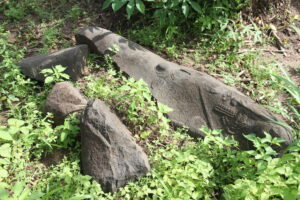
Damaged monolith in farmland at Nkunkundah. Site_Edamkono.
Allison’s survey was commissioned by John Picton (Professor Emeritus at SOAS), then of the Nigerian Department of Antiquities (now the National Commission for Museums and Monuments, or NCMM), who donated the archive to the Bodleian Library in 2017. With access to the entirety of Allison’s material, as well as the local knowledge gathered on repeated visits, it was possible to gradually piece together a picture of the theft and international trade of the monoliths.
The Bakor region is located on the border of Cameroon and was part of the attempted breakaway state of Biafra. Today the region has been subject to further instability on account of another attempted breakaway state, Ambazonia, which comprises the Anglophone districts of western Cameroon and has caused an influx of refugees into eastern Nigeria. From the civil war of the late 1960s onwards, a large number of monoliths were removed from the sites (likely using the heavy logging machinery with which the region’s forests were cut down) and taken over the border, from where they entered the international antiquities market. According to Professor Picton, theft was not a problem before the civil war.
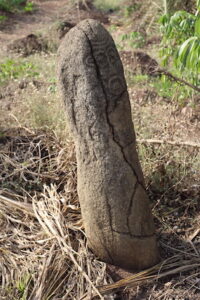
A burned and cracked monolith at Manden.
Allison’s documentation led to the discovery of several monoliths in prominent international collections. In October 2016, Factum recorded the base half of a monolith (Fig. 3) using photogrammetry at a site called Ntitogo (Nnam clan, referred to by Allison as ‘Ntetakor’), the top half of which was identified by Dr. Abu Solomon Edet and Dr. Ivor Miller of UNICAL in the Metropolitan Museum of Art, New York (Fig. 5). After securing permission to record the top fragment in 2018, Factum produced a scaled-down reunited facsimile that was presented to a conference on the monoliths at UNICAL in the same year; this was afterwards gifted to the Paramount Ruler of the Bakor People, Ntol Emang (Fig. 4). Factum also recorded a monolith identifiable from the site Eting Nta (Nta clan) at the Musée Quai Branly, Paris, which had been purchased from the Brussels-based dealer Pierre Dartevelle in 1998 (Fig. 6). According to older members of Eting Nta village, this monolith was stolen in the 1970s and is known to the community by the name ‘Ebi Abu’.
During a visit to Eting Nta in September 2019, an assembled group of elders broke into an impromptu rendition of the phrase ‘bring back Ebi Abu to us’ to the tune of the song ‘My bonnie lies over the ocean.’ The name connects the stone to the secret society ‘Ekpe’, which uses uncarved monoliths in its contemporary rituals and is involved in the transmission of ancestral knowledge (Fig. 7). Ekpe also uses a symbolic language called ‘Nsibidi’ which some practitioners identify with the patterns found on the Bakor monoliths. Dartevelle, who in the course of his collecting travelled widely in ‘Cameroon, the Congo and West Africa’, also has another monolith from Eting Nta (in Allison’s reference system ‘E10’) listed on his gallery’s website (Fig. 8).

Community at Oyengi asking for the return of their monoliths.
Research online also led to the discovery of a monolith not documented by Allison belonging to the Brussels-based dealer Didier Claes. Upon receiving permission to record this example, Factum travelled to a warehouse in the outskirts of Brussels to record it in 2018. The warehouse manager brought out two examples wrapped in blankets, neither of which proved to be the monolith expected from the picture online. One was identifiable from Allison’s archive as originating from the site Oyengi (Nta clan, ‘OY2’, Figs. 9–10), while the other, which was exhibited in the sculpture garden at Frieze Masters in 2015 and has abrasive marks down one side, appeared similar to those found at a site not recorded by Allison called Bonima (Abanyom clan, Fig. 11).
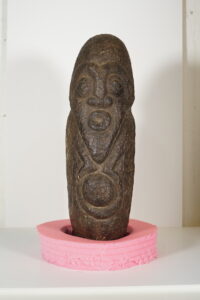
Probable modern monolith in the collection of The Israel Museum.
In the early 1960s, Oyengi had four carved monoliths and one uncarved. Today, only one carved and one uncarved remain; of the other three phallic-style examples, aside from the one in the Claes collection, one is missing and the other is owned by Dartevelle (Figs. 12–13). The chief of Oyengi entreated us to help return it and the other monoliths to his community (Fig. 14). Another online search led to the discovery of a limestone example identifiable from a site called Akumabal (Abanyom clan, ‘AK1’) held in the collection of Jerome and Ellen Stern in East Hampton, USA. This monolith was donated in 2018 to the Israel Museum in Jerusalem, where Factum recorded it in December 2019 (Fig. 15). Akumabal is the site of the Bakor meeting house, but the original location of the stones is unknown. These case studies are just a selection and many other monoliths registered on the websites of auction houses could be cited.
A parallel aspect to the theft, removal and trade in the Bakor monoliths since the Biafran civil war has been the circulation of monoliths that our project believes to be inauthentic on grounds of style, scale and material. One possible example held in the collection of the British Museum was verified by Philip Allison, but the stone it is carved from appears to be granite rather than basalt or limestone (Fig. 16). In terms of style, it is almost identical to one held by the Israel Museum and another acquired in 2019 by the New Orleans Museum of Art; it therefore seems likely that they were produced by the same workshop. Dr. Edet believes that there was a workshop which produced ‘fakes’ across the border in Cameroon.
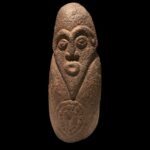
Probable modern monolith in the collection of the New Orleans Museum of Art.
In the Bakor region, there are two carvers active that our project is aware of, Philip Nsuko of Njemetop village (Nselle clan) and Ekon Nsakpe of Emeakpen village (also Nselle), both of whom are convinced that the British Museum example is not authentic.
The British Museum’s monolith will be the departure point for an exhibition on the subject of the Bakor monoliths that will open at the museum on 1 October 2020, Nigerian Independence Day. The exhibition will then run through November and another relevant date: the 50th anniversary of the 1970 UNESCO Convention on the Means of Prohibiting and Preventing the Illicit Import, Export and Transfer of Ownership of Cultural Property. The exhibition will draw on the research project, asking questions about the role of digital technology in documentation, preservation and restitution.
Following its conclusion, we hope that contents from the exhibition, including 1:1 high-resolution facsimiles, will be shipped back to Nigeria and displayed first in an exhibition at the Calabar National Museum, then as a permanent exhibition installation at the Alok Open Air Museum. Other facsimiles will be returned to their original sites as one aspect of the ongoing community engagement activities aimed at supporting the local preservation of the monoliths.
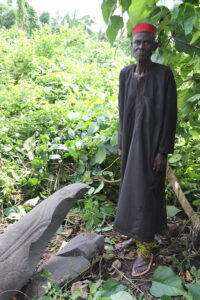
The Chief of Neborokpa pictured with a broken monolith at Neborokpa village.
The Bakor monoliths project demonstrates that blanket solutions to the question of how to respond to Europe’s colonial legacy with regard to Africa’s material heritage are ineffective. Although the Bakor communities have a legitimate claim to the restitution of objects of the highest spiritual and cultural value to them, at this stage it is unrealistic to simply return the monoliths to sites which for the most part are still farm lands and throughout which damaged monolith fragments are scattered. Through the project and the exhibition, Factum Foundation hopes to present an effective model for addressing preservation and the problem of restitution, involving the development of long-term relationships both with national heritage bodies such as the NCMM and local communities.
The first stage in the relationship is documentation. In the present context, Philip Allison’s survey is ample proof of the necessity of comprehensive recording with the most up-to-date tools available: in the 1960s a black and white film camera, today high-resolution 3D scanning. Perhaps more than anything else, this documentation is a powerful deterrent to theft. The second stage is community engagement. On Factum’s first visit to the region, a frequent complaint was that university researchers had come to study the monoliths, received considerable help from the communities, and then failed to share any of the results with them.
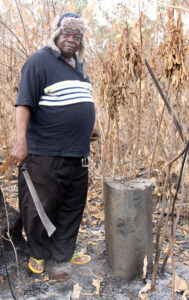
Chief Sylvanus “Orlando” Akong pictured with the bottom half of a monolith at Ntitogo, the top half of which is in The Metropolitan Museum of Art, NY.
Our repeated visits to communities have gradually built up the trust lost by academics and we have tried to ensure that all the various clan groups are given equal time and attention. A key element of this stage in the project will be the permanent exhibition at the Alok Open Air Museum, generously supported by the Carène Foundation, and the activities planned to engage young community members from across all clans. Without the pride of the local community in the monoliths and the conviction that the sites can be effectively managed, all external attempts at preservation will ultimately be futile. Finally, as to the question of restitution, Factum believes that returning exact facsimiles can serve a valuable role as a stepping-stone towards the eventual return of originals, with the provision that the context they are returning to is entirely safe. It is hoped that bringing back even a facsimile of ‘Ebi Abu’ will inspire the Bakor communities to preserve their precious heritage.
With thanks to the Paramount Ruler of the Bakor people, Ntol Emang and Chief Sylvanus ‘Orlando’ Akong, and all the clan and village leaders who have helped facilitate our work in the region. Thanks also to the Nigerian rock art team: Dr. Abu Solomon Edet, Dr. Frank Enor, Dr. Ivor Miller, David Coulson, Terry Little, Dr. Abubakar Sule, Edith Ekunke, Dr. Clement Bakinde, Dr. Asmau Ahmed Giade, Dr. Mohammed Sanni, Aliyu Abdu, Salisu Aminu, Mohammed Adam, Uzoma Nwosu, Sam Ntino, Dr. Ekwutosi Offi ong, Evelyn Osuwagu, Dr. Joy Ejikeme, Dr. Angela Ajimase. And to Jim and Paula Crown, the Prince Claus Fund, the US Ambassador’s Fund for Cultural Preservation and the Carène Foundation for their generous support.
See also Cultural Property News: The Interview: Adam Lowe of Factum Arte for more on the groundbreaking publication The Aura in the Age of Digital Materiality: Rethinking Preservation in the Shadow of an Uncertain Future, issued by Factum Foundation, and Factum Arte’s extraordinary work.
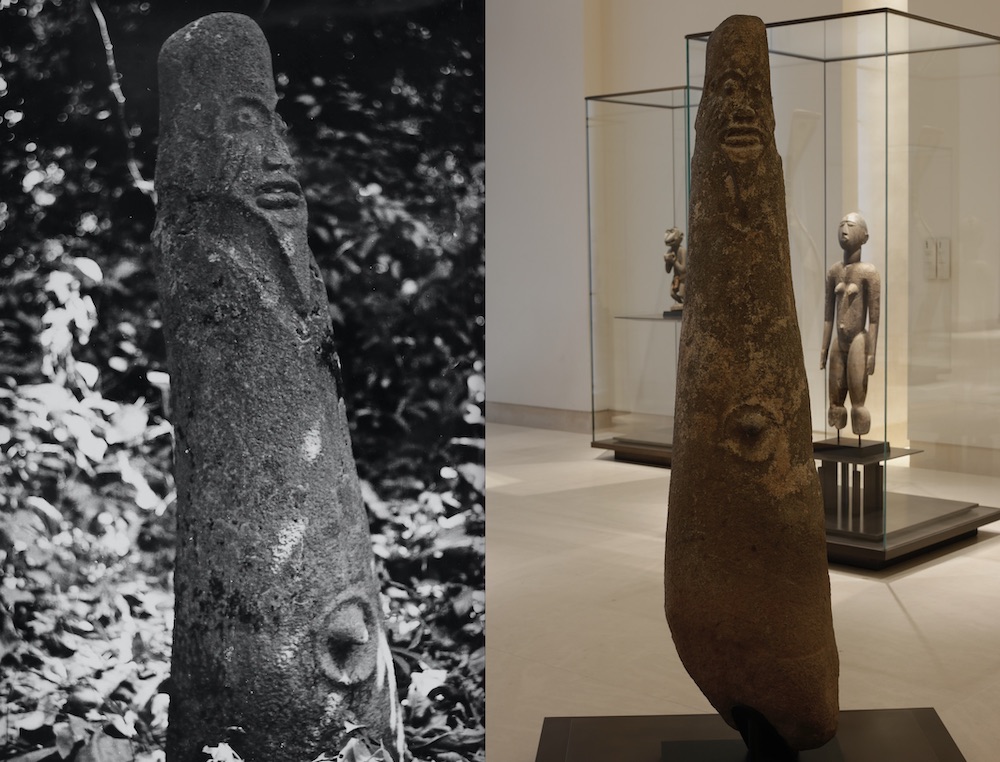 Eting Nta monolith in Allison’s survey 1961/62 and in the collection of the Musée du Quai Branly, photo Photos in this article by Ferdinand Saumarez Smith unless otherwise noted, Courtesy Factum Foundation.
Eting Nta monolith in Allison’s survey 1961/62 and in the collection of the Musée du Quai Branly, photo Photos in this article by Ferdinand Saumarez Smith unless otherwise noted, Courtesy Factum Foundation. 

